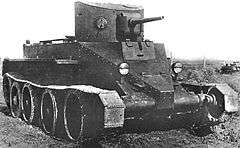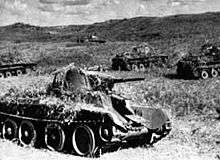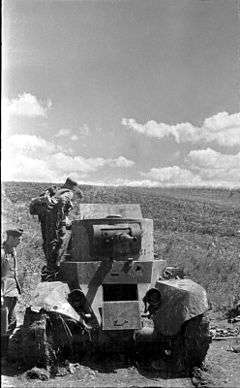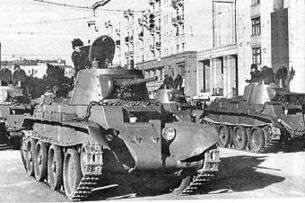BT tank
| BT-2, BT-5, BT-7, BT-7M | |
|---|---|
|
BT-7 | |
| Type | Light cavalry tank |
| Place of origin | Soviet Union |
| Service history | |
| In service | 1932–45 |
| Wars | Spanish Civil War, Second Sino–Japanese War, Soviet–Japanese border conflicts, Winter War, World War II |
| Production history | |
| Designer | J. Walter Christie, Kharkiv Morozov Machine Building Design Bureau (KMDB) |
| Designed | 1930–31 |
| Manufacturer | Malyshev Factory |
| Produced | 1932–41 |
| Number built | BT-2: 650 BT-5: 1884 BT-7: 5556 |
| Variants | BT-2, BT-5, BT-7, BT-7M |
| Specifications (BT-5) | |
| Weight | 11.5 tonnes (12.676 tons) |
| Length | 5.58 m (18 ft 4 in) |
| Width | 2.23 m (7 ft 4 in) |
| Height | 2.25 m (7 ft 5 in) |
| Crew | 3 |
|
| |
| Armour | 6–13 mm |
Main armament | 45-mm Model 32 tank gun |
Secondary armament | 7.62-mm DT machine gun |
| Engine |
Model M-5 400 hp (298 kW) |
| Power/weight | 35 hp/tonne |
| Suspension | Christie |
| Fuel capacity | 360 litres (95 US gal) |
Operational range | 200 km (120 mi) |
| Speed | 72 km/h (44.7 mph) |
The BT tanks (Russian: Быстроходный танк (БТ), Bystrokhodny tank, lit. "fast moving tank" or "high-speed tank")[1] were a series of Soviet light tanks produced in large numbers between 1932 and 1941. They were lightly armoured, but reasonably well-armed for their time, and had the best mobility of all contemporary tanks in the world at that time. The BT tanks were known by the nickname Betka from the acronym, or its diminutive Betushka.[2] The successor of the BT tanks would be the famous T-34 medium tank, introduced in 1940, which would replace all of the Soviet fast tanks, infantry tanks, and medium tanks in service.
Design
The BT tanks were "convertible tanks". This was a feature designed by J. Walter Christie to reduce wear of the unreliable tank tracks of the 1930s. In about thirty minutes, the crew could remove the tracks and engage a chain drive to the rearmost road wheel on each side, allowing the tank to travel at very high speeds on roads. In wheeled mode, the tank was steered by pivoting the front road wheels. Soviet tank forces soon found the convertible option of little practical use; in a country with few paved roads, it consumed space and added needless complexity and weight. The feature was dropped from later Soviet designs.
Christie, a race car mechanic and driver from New Jersey, had failed to convince the U.S. Army Ordnance Bureau to adopt his Christie tank design. In 1930, Soviet agents at Amtorg, ostensibly a Soviet trade organization, used their New York political contacts to persuade U.S. military and civilian officials to provide plans and specifications of the Christie tank to the Soviet Union. At least two of Christie's M1931 tanks (without turrets) were later purchased in the United States and sent to the Soviet Union under false documentation, in which they were described as "agricultural tractors".[3] Both tanks were delivered to the Kharkov Komintern Locomotive Plant (KhPZ). The original Christie tanks were designated fast tanks by the Soviets, abbreviated to BT (later referred to as BT-1). Based both on them and on other plans obtained earlier, three unarmed BT-2 prototypes were completed in October 1931 and mass production began in 1932. Most BT-2s were equipped with a 37 mm gun and a machine gun, but a shortage of 37 mm guns led to some early examples being fitted with three machine guns. The sloping front hull (glacis plate) armor design of the Christie M1931 prototype was retained in later Soviet tank hull designs, later adopted for side armor as well. The BT-5 and later models were equipped with a 45 mm gun.
Variants


Soviet Union variants:
- BT-1: Christie prototype with no turret.
- BT-2 Model 1932: M-5-400 engine (copy of U.S. Liberty engine); three turret versions were produced: with single 37mm gun; 37mm gun and one DT machine gun; twin DP machine guns mount and a single machine gun. In late 1932, modified to BT-3 but produced under the same designation.
- BT-3: same as BT-2, produced according to metric system (instead of Imperial system as used for BT-2). In official documentation referred to as BT-2.
- BT-4: was a design with welded hull and minor changes in the suspension. 3 prototypes produced (with partially riveted hull)
- BT-5: larger cylindrical turret, 45mm 20-K gun, coaxial DT machine gun.
- BT-5 Model 1933: new turret with twin hatches and larger bustle.
- BT-5PKh: snorkelling variant (prototypes only).
- BT-5A: artillery support version with 76.2mm howitzer (few made).
- RBT-5: rocket launcher artillery version, equipped with two 420mm tank torpedoes (prototypes only).
- BT-5 flamethrower tank: (prototypes only).
- BT-5-IS: experimental model with heavily sloped front armor, it served as "sloped armor testbed" together with the BT-SW-2 experimental tank.
- PT-1A: amphibious variant with new hull (few made).
- TT-BT-5: teletank, remote-radio-controlled tank.
- BT-7 Model 1935: welded hull, redesigned hull front, new Mikulin M-17T engine (licensed copy of a BMW engine), enclosed muffler.
- BT-7 Model 1937: new turret with sloping armour.
- BT-7TU: command version, with whip antenna instead of earlier frame antenna.
- BT-7A: artillery support version with a 76.2 mm howitzer; a 7.62mm DT machine gun was on the turret rear. 155 were made.
- OP-7: flame-thrower version with external fuel panniers (prototype only).
- TT-BT-7: teletank, remote-radio-controlled tank.
- BT-SV-2 Cherepakha ("turtle"): another prototype, this took armour sloping to an extreme.
- BT-7M[4] (1938, prototypes designated A-8; sometimes referred to as BT-8): new V-2 diesel engine replacing earlier gasoline engines, three DT machine guns: coaxial, in P-40 AA mount on roof and in a ball-mount on turret rear.
- A-20 (also known as BT-20): prototype for a new BT tank, with 20mm armour, 45mm 20-K gun, model V-2 diesel engine, and 8×6-wheel convertible drive. Lost out in trials to the A-32, which was further improved and produced as the T-34 medium tank. The only built prototype is known to have participated in the Battle of Moscow. In 1941, as the Germans neared Moscow, the situation was so desperate that everything battle-worthy was put into service by the Soviets. The A-20 prototype, which at that time was at Kubinka army proving ground near Moscow for evaluation trials, was immediately put into service together with other prototypes of tanks present here, which were organized into a separate company led by Captain Semenov. Later on, the tank was included in the 22nd Tank Brigade organic, together with its predecessors and successors, BT-7 and T-34 tanks. On December 1, 1941, during fighting, the tank was seriously damaged and sent to the rear for repairs. Three days later, it re-entered service with the 22nd Tank Brigade until mid-December, when the tank was again damaged and evacuated to the rear. After these events, its fate is unknown.
- A-32 (A-20G): initially known as the A-20G (G - tracked) and then renamed to A-32, it was the competitor to the A-20. The wheels-and-tracks system was removed for the first time from the BT tanks series, making the tank design and production easier, more reliable and, especially, lighter; in fact, armor was increased to 30mm, hull was enlarged and the 45mm 20-K gun was replaced by the 76.2mm L-11 gun, but the weight increased by only 1 ton (from 18 to 19 tons, respectively for the A-20 and A-32). Trials in 1939 showed that the tank armor could be upgraded and thus a request for increase to 45mm was made. A second prototype was specially created for the purpose, this time equipped with turret and 45mm armament from the A-20 and with additional weights placed on special brackets welded on the hull and turret to simulate mass of the up-armored tank. After satisfactory tests, other requests were made, for example to improve the visibility from inside the tank and to adopt the newer F-32 gun (later the F-34 was adopted on production models instead), which finally lead to the A-34, serial produced as the famous T-34.
Foreign variants:
- BT-42: Finnish assault gun; captured BT-7s were equipped with British 114 mm howitzers. The co-axial DT gun was removed and turret re-designed to accommodate the new gun. Only 18 were made.
- BT-43: Finnish armoured personnel carrier; captured BT-7s equipped with troop accommodation.
Specifications
| BT-2 | BT-5 | BT-7 | BT-7A | BT-7M (BT-8) | |
|---|---|---|---|---|---|
| number built | 620 | 2,108[6] or 5000[7] |
4,965[8] or 2000[7] |
154 | 790[4] |
| crew | 3 | 3 | 3 | 3 | 3 |
| weight | 10.2 t | 11.5 t | 14 t | 14.5 t | 14.7 t |
| length | 5.58 m | 5.58 m | 5.66 m | 5.66 m | 5.66 m |
| width | 2.23 m | 2.23 m | 2.29 m | 2.29 m | 2.29 m |
| height | 2.20 m | 2.25 m | 2.42 m | 2.52 m | 2.42 m |
| armour | 6–13 mm | 6–13 mm | 6–13 mm | 6–13 mm | 6–22 mm |
| main gun | 37 mm Model 30 |
45 mm Model 32 |
45 mm Model 35 |
76.2 mm Model 27/32 |
45 mm Model 38 |
| main gun ammunition |
96 rounds | 115 rounds | 146 rounds | 50 rounds | 146 rounds |
| machine guns | DT | DT | DT | 2×DT | 3×DT |
| engine power model |
400 hp M-5 |
400 hp M-5 |
500 hp M-17T |
500 hp M-17T |
450 hp V-2 |
| fuel | 400 l gasoline |
360 l gasoline |
620 l gasoline |
620 l gasoline |
620+170 l diesel |
| road speed | 100 km/h (62 mph) | 72 km/h (45 mph) | 86 km/h (53 mph) | 86 km/h | 86 km/h |
| power:weight | 39 hp/t | 35 hp/t | 36 hp/t | 34 hp/t | 31 hp/t |
| road range | 300 km | 200 km | 250 km | 250 km | 700 km |
| tactical range | 100 km | 90 km | 120 km | 120 km | 400 km |
Combat history


BT tanks saw service in the Second Sino-Japanese War, Spanish Civil War, Battle of Khalkhin Gol (Nomonhan), the Winter War in Finland, the Polish campaign and in World War II. In the Spanish Civil War, a battalion of BT-5s fought on the Republican side and their 45 mm guns could easily knock out the opposing German and Italian light tanks. The Chinese Nationalist Army also had 4 BT-5s and they fought against the Japanese Imperial Army during the Second Sino-Japanese War.
World War II in East-Asia
During the Battles of Khalkhin Gol (also known as the Nomonhan Incident), which lasted from May to September in 1939, BT tanks were easily attacked by Japanese "close quarter" teams[9] (tank killer squads)[10] which were—in lieu of anti-tank weapons—armed with petrol bottles[11] (later called "Molotov cocktails"). The Soviet BT-5 and BT-7 light tanks, which had been operating in temperatures greater than 100F on the Mongolian plains, easily caught fire when a Molotov cocktail ignited their gasoline engines.[12] General Georgy Zhukov made it one of his "points" when briefing Joseph Stalin, that his "...BT tanks were a bit fireprone...."[13][14][15] Conversely, many Japanese tank crews held the Soviet 45mm anti-tank/tank guns in high esteem, noting, "...no sooner did they see the flash from a Russian gun, than they'd notice a hole in their tank, adding that the Soviet gunners were accurate too!"[16]
After the Khalkhin Gol War in 1939, the Soviet military had broken into two camps; one side was represented by Spanish Civil War veterans General P. V. Rychagov of the Soviet Air Force, Soviet armour expert General Dimitry Pavlov, and Stalin's favorite, Marshal Grigory Kulik, Chief of Artillery Administration.[17] The other side consisted of the Khalkhin Gol veterans led by Generals Zhukov and G. P. Kravchenko of the Soviet Air Force.[18] The lessons of Russia's "first real war on a massive scale using tanks, artillery, and airplanes" at Nomonhan (Khalkhin Gol) went unheeded.[19][20] During the Finland War (Winter War), BT-2 and BT-5 tanks were less successful.[19]
During the final weeks of World War II, a significant number of BT-7 tanks took part in the Soviet invasion of Manchuria against the Japanese occupation, in August 1945. This was the last combat action for the BT tanks.
World War II in Europe
During the Second World War in Europe, BT-5 and BT-7 tanks were used in the 1939 Soviet invasion of Poland and in large numbers in the battles of 1941, during which thousands were abandoned or destroyed. A few remained in use in 1942, but were rare after that time. The Red Army planned to replace the BT tank series with the T-34 and had just begun doing so when the German invasion (Operation Barbarossa) began.
Operators
-
 Soviet Union
Soviet Union -
 Afghanistan
Afghanistan -
 Republic of China (4 BT-5s)
Republic of China (4 BT-5s) -
 Finland (Captured)
Finland (Captured) -
 Hungary (Captured)
Hungary (Captured) -
.svg.png) Nazi Germany (Captured)
Nazi Germany (Captured) -
 Mongolia
Mongolia -
.svg.png) Spanish Republic
Spanish Republic -
.svg.png) Spanish State (Captured)
Spanish State (Captured)
Technical legacy

The BT tank series was numerous, forming the cavalry tank arm of the Red Army in the 1930s and had much better mobility than other contemporary tank designs. For these reasons, there were many experiments and derivatives of the design, mostly conducted at the KhPZ factory in Kharkov.
The most important legacy of the BT tank was the T-34 medium tank, arguably the most important tank of World War II. In 1937, a new design team was formed at the KhPZ to create the next generation of BT tanks. Initially, the chief designer was Mikhail Koshkin and after his death, Morozov. The team built two prototypes. The light one was called the A-20. The more heavily armed and armoured BT derivative, the A-32, was a "universal tank" to replace all the T-26 infantry tanks, BT cavalry tanks and T-28 medium tanks. Such a plan was controversial, but concerns about tank performance under the threat of the German blitzkrieg led to the approval for production of a still more heavily armoured version, the T-34 medium tank.
Along the way, an important technical development was the BT-IS and BT-SW-2 testbed vehicles, concentrating on sloped armour. This proof-of-concept led directly to the armour layout of the T-34. BT tank chassis were also used as the basis for engineering support vehicles and mobility testing vehicles. A bridgelayer variant had a T-38 turret and launched a bridge across small gaps. Standard tanks were fitted as fascine carriers. The RBT-5 hosted a pair of large artillery rocket launchers, one on each side of the turret. Several designs for extremely wide tracks, including, oddly, wooden 'snowshoes' were tried on BT tanks.
The KBT-7 was a thoroughly modern armoured command vehicle that was in the prototype stage when World War II broke out. The design was not pursued during the war.
In the Kiev maneuvers of 1936, foreign military observers were shown hundreds of BT tanks roll by a reviewing stand. In the audience were British Army representatives, who returned home to advocate for use of Christie suspension on British cruiser tanks, which they incorporated from the Cruiser Mk III onwards. The pointed shape of the hull front armor on the BT tank also influenced the design of the British Matilda tank.
Footnotes
- ↑ Coox p. 641 notation #23
- ↑ Zaloga 1984, p 74.
- ↑ Suvorov, Viktor "The Chief Culprit: Stalin's Grand Design to Start World War II" Naval Institute Press 2008 ISBN 9781591148067 Chapter 9
- 1 2 BT-7M Light Wheeled/ Tracked Tank at KMDB.
- ↑ Zaloga & Grandsen, Soviet Tanks and Combat Vehicles of World War Two
- ↑ "BT-5 Light Wheeled/ Tracked Tank". Kharkiv Morozov Machine Building Design Bureau. Archived from the original on 2006-07-17.
- 1 2 http://www.wwiivehicles.com/ussr/tanks-medium/bt-7.asp
- ↑ BT-7 Light Wheeled/ Tracked Tank at KMDB.
- ↑ Coox p.318
- ↑ Coox pp. 311 & 318
- ↑ Coox p. 309
- ↑ Coox p. 300
- ↑ Coox p. 437
- ↑ Coox p. 993
- ↑ Goldman p. 123
- ↑ Coox pp. 400, 362
- ↑ Coox p. 993-996
- ↑ Coox pp. 994–995
- 1 2 Coox p. 997
- ↑ Goldman p. 123, 167
References
- Chamberlain, Peter, and Chris Ellis (1972). Tanks of The World. London: Cassell & Co. ISBN 0-304-36141-0.
- Coox, Alvin D. Nomonhan; Japan Against Russia, 1939. 1985; 2 volumes. Stanford University Press. ISBN 0-8047-1160-7.
- Goldman, Stuart D (2012). Nomonhan, 1939; The Red Army's Victory That Shaped World War II. Naval Institute Press. ISBN 978-1-59114-329-1.
- Zaloga, Steven J.; James Grandsen (1984). Soviet Tanks and Combat Vehicles of World War Two. London: Arms and Armour Press. ISBN 0-85368-606-8.
External links
| Wikimedia Commons has media related to BT tank. |
- BT-2 Tank at the Russian Battlefield
- BT-5 Tank at the Russian Battlefield
- BT-7 Tank at the Russian Battlefield
- BT tanks and their variants at Henk of Holland
- Salvage of BT-7 tank from Neva river
- BT tanks, BT tanks in museum and monuments
- Detailed article about early history of BT tanks automatically translated from Russian
